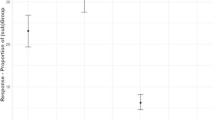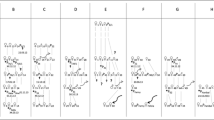Summary
Vigilance behavior, predator detection abilities, and responses to real and model predators were studied in two species of capuchin monkeys (Cebus albifrons and C. apella) in a Peruvian lowland rain forest. Adult males were more vigilant than adult females in both species, mainly because the males spent less time feeding and foraging and partly because they were at the periphery more often than the females. The increased vigilance of adult males is reflected in their superior performance in the detection of (model) predators. Adult and subadult males were also far more likely to approach and mob real and model predators. Adults that were outside the center of the group increased foraging activities but cut back an feeding, much of which was done in exposed tree crowns. Current theory suggests that primate groups are multi-male when a single male is unable to defend sexual access to the group of females. In these small capuchin groups, which are multimale, the enhanced safety of females and young provided by extra adult males furnishes a more plausible explanation. A comparison of the two capuchins with the ecologically similar Southeast Asian Macaca fascicularis suggests that the high predation risk outside the group may also have caused the unusual male career profile in capuchins, which have a long tenure of dominants and a very long potential lifespan. Further predictions of this hypothesis are developed.
Similar content being viewed by others
References
Altmann J (1974) The observational study of behavior. Sampling methods. Behaviour 49:227–267
Andelman S (1986) Ecological and social determinants of cercopithecine mating patterns. In: Rubenstein DI, Wrangham RW (eds) Ecological aspects of social evolution. Princeton University Press, Princeton, pp 201–216
Bennet EL (1983) The banded langur: ecology of a colobine in West Malaysian rain forest. PhD thesis, University of Cambridge, Cambridge
Bertram BCR (1982) Problems with altruism. In: King's college sociobiology group (eds) Current problems in sociobiology. Cambridge University Press, Cambridge, pp 251–267
Bowden DM, Jones ML (1979) Aging research in nonhuman primates. In: Bowden DM (ed) Aging in nonhuman primates. Reinhold, New York, pp 1–13
Brown LH, Amadon D (1968) Eagles, hawks and falcons of the world. Hamlyn, Feltham
Caro TM (1986) The functions of stotting in Thomson's gazelles: some tests of the hypotheses. Anim Behav 34:663–684
Chapman CA (1986) Boa constrictor predation and group response in white-faced cebus monkeys. Biotropica 18:171–172
Cheney DL, Seyfarth RM (1981) Selective forces affecting the predator alarm call of vervet monkeys. Behaviour 76:25–61
Cheney DL, Wrangham RW (1987) Predation. In: Smuts BB, Cheney DL, Seyfarth RM, Wrangham RW, Struhsaker TT (eds) Primate societies. University of Chicago Press, Chicago, pp 227–239
Crook JH (1970) The socio-ecology of primates. In: Crook JH (ed) Social behaviour in birds and mammals. Academic Press, London, pp 103–166
Crook JH (1972) Sexual selection, dimorphism, and social organization in the primates. In: Campbell BG (ed) Sexual selection and the descent of man. Aldine, Chicago, pp 231–281
Crook JH, Gartlan JS (1966) On the evolution of primate societies. Nature 210:1200–1203
Curio E (1980) An unknown determinant of a sex-specific altruism. Z Tierpsychol 53:139–152
Darwin C (1871) The descent of man and selection in relation to sex. Murray, London
DeVore I (1963) Comparative ecology and behavior of monkeys and apes. In: Washburn SL (ed) Classification and human evolution. Wenner, New York, pp 301–319
Dunbar RIM (1984) Reproductive decisions, an economic analysis of gelada baboon social strategies. Princeton University Press, Princeton
Dunbar RIM, Sharman M (1983) Female competition for access to males affects birth rate in baboons. Behav Ecol Sociobiol 13:157–159
Eisenberg JF, Muckenhirn NA, Rudran R (1972) The relation between ecology and social structure in primates. Sciences 176:863–874
Emlen ST (1984) Cooperative breeding in birds and mammals. In: Krebs JR, Davies NB (eds) Behavioural ecology: an evolutionary approach. Blackwell, Oxford, pp 305–339
Emlen ST, Oring LW (1977) Ecology, sexual selection, and the evolution of mating systems. Science 197:215–223
Emmons LH (1987) Comparative feeding ecology of felids in a neotropical rain forest. Behav Ecol Sociobiol 20:271–283
Gautier-Hion A, Quris R, Gautier J-P (1983) Monospecific vs polyspecific life: a comparative study of foraging and antipredatory tactics in a community of Cercopithecus monkeys. Behav Ecol Sociobiol 12:325–335
Goss-Custard JD, Dunbar RIM, Aldrich-Blake FPG (1972) Survival, mating and rearing strategies in the evolution of primate social structure. Folia Primatol 17:1–19
Greene HW (1983) Boa constrictor (Boa, Béquer, Boa constrictor). In: Janzen DH (ed) Costa Rican natural history. University of Chicago Press, Chicago, pp 380–382
Harcourt AH (1978) Strategies of emigration and transfer by primates with particular reference to gorillas. Z Tierpsychol 48:401–420
Howe HF (1979) Fear and frugivory. Am Nat 114:925–931
Izawa K (1980) Social behavior of the wild black-capped capuchin (Cebus apella). Primates 21:443–467
Janson CH (1984) Female choice and mating system of the brown capuchin monkey Cebus apella (Primates: Cebidae). Z Tierpsychol 65:177–200
Janson CH (1985a) Ecological and social consequences of food competition in brown capuchin monkeys. PhD thesis, Washington University, Seattle
Janson CH (1985b) Aggressive competition and individual food consumption in wild brown capuchin monkeys (Cebus apella). Behav Ecol Sociobiol 18:125–138
Janson CH (1986) The mating system as a determinant of social evolution in capuchin monkeys (Cebus). In: Else J, Lee PC (eds) Primate ecology and conservation. Cambridge University Press, Cambridge, pp 169–179
Lawrence ES (1985) Vigilance during ‘easy’ and ‘difficult’ foraging tasks. Anim Behav 33:1373–1375
Maynard Smith J (1983) Game theory and the evolution of cooperation. In: Bendall DS (ed) Evolution from molecules to men. Cambridge University Press, Cambridge, pp 445–456
McFarland Symington M (1989) Spider monkey response to predator playbacks depends on group composition. (in press)
Noordwijk MA van, Schaik CP van (1985) Male migration and rank aquisition in wild long-tailed macaques, Macaca fascicularis. Anim Behav 33:849–861
Noordwijk MA van, Schaik CP van (1988) Male careers in Sumatran long-tailed macaques (Macaca fascicularis). Behaviour 107:24–43
Pulliam HR, Caraco T (1984) Living in groups: is there an optimal group size? In: Krebs JR, Davies NB (eds) Behavioural ecology: an evolutionary approach. Blackwell, Oxford, pp 122–147
Rettig NL (1978) Breeding behavior of the harpy eagle (Harpia harpyia). Auk 95:629–643
Ridley M (1986) The number of males in a primate troop. Anim Behav 34:1848–1858
Robinson JG (1981) Spatial structure in foraging groups of wedge-capped capuchin monkeys Cebus nigrivittatus. Anim Behav 29:1036–1056
Robinson JG (1982) Intrasexual competition and mate choice in primates. Am J Primatol (Suppl) 1:131–144
Robinson JG (1984) Diurnal variation in foraging and diet in the wedge-capped capuchin Cebus olivaceus. Folia Primatol 43:216–228
Robinson JG (1989) Demography and group structure in wedge-capped capuchin monkeys, Cebus olivaceus. Behaviour (in press)
Robinson JG, Janson CH (1987) Capuchins, squirrel monkeys, and Atelines: ecological and social convergence with Old World primates. In: Smuts BB, Cheney DL, Seyfarth RM, Wrangham RW, Struhsaker TT (eds) Primate societies. University of Chicago Press, Chicago, pp 69–82
Ruiter JR de (1986) The influence of group size on predator scanning and foraging behaviour of wedgecapped capuchin monkeys (Cebus olivaceus). Behaviour 98:240–258
Schaik CP van (1983) Why are diurnal primates living in groups? Behaviour 87:120–144
Schaik CP van, Hooff JARAM van (1983) On the ultimate causes of primate social systems. Behaviour 85:91–117
Schaik CP van, Noordwijk MA van (1986) The hidden costs of sociality: intra-group variation in feeding strategies in Sumatran long-tailed macaques (Macaca fascicularis). Behaviour 99:296–315
Schaik CP, Noordwijk MA van, Warsono B, Sutriono E (1983) Party size and early detection of predators in Sumatran forest primates. Primates 24:211–221
Smuts BB (1986) Sexual competition and mate choice. In: Smuts BB, Cheney DL, Seyfarth RM, Wrangham RW, Struhsaker TT (eds) Primate societies. University of Chicago Press, Chicago, pp 385–399
Struhsaker TT (1981) Polyspecific associations among tropical rain-forest primates. Z Tierpsychol 57:268–304
Struhsaker TT, Leland J (1979) Socioecology of five sympatric monkey species in the Kibale forest, Uganda. Adv Study Behav 9:159–227
Terborgh JW (1983) Five new world primates, a study in comparative ecology. Princeton University Press, Princeton
Author information
Authors and Affiliations
Rights and permissions
About this article
Cite this article
van Schaik, C.P., van Noordwijk, M.A. The special role of male Cebus monkeys in predation avoidance and its effect on group composition. Behav Ecol Sociobiol 24, 265–276 (1989). https://doi.org/10.1007/BF00290902
Received:
Accepted:
Issue Date:
DOI: https://doi.org/10.1007/BF00290902




